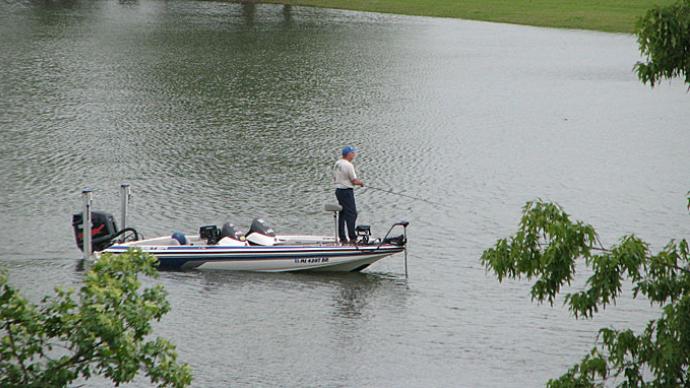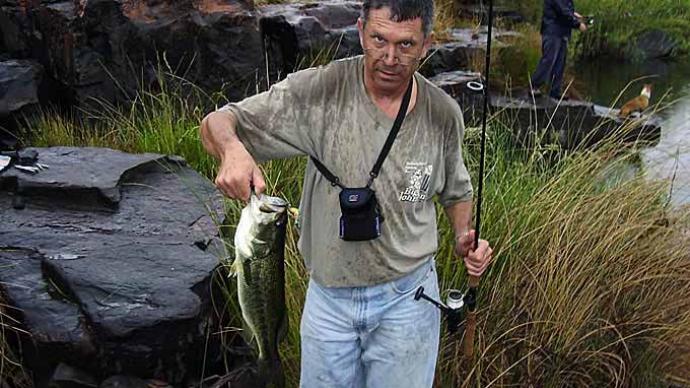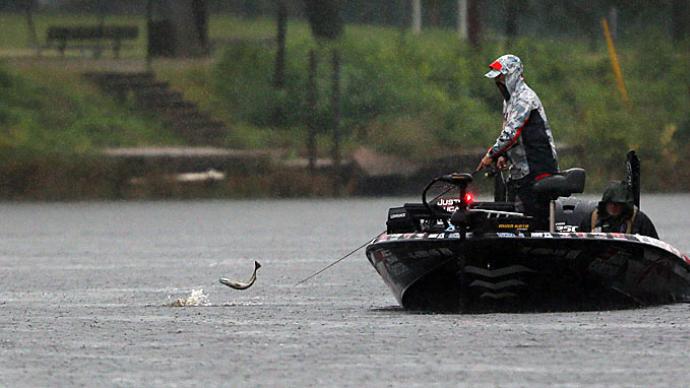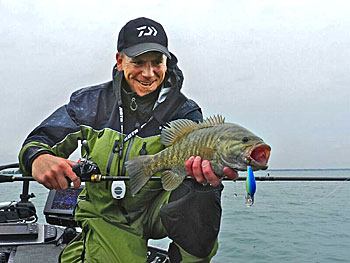
In general, anglers do not like fishing in the rain. Can you blame them? It’s uncomfortable, sometimes cold, and not in the best conditions. Or is it? The bass don’t care. They’re not getting any wetter! And a good soaking rain can trigger largemouth bass to a heightened level of activity that results in great fishing. So, you’d better suck it up, break out the rain gear and assume a mindset to take advantage of it.
“I don’t think that rain is as good for smallmouths as it is for largemouths,” stated tournament pro, bass enthusiast, and owner of Millennium Promotions, Inc. Joe Balog. “Fronts, clouds, wind, and rain are good for largemouths. It makes it more challenging for them to see you, they are more at ease and more aggressive when it’s overcast and dark, and they’re more prone to venture farther from cover.
“Smallmouths, on the other hand, are sight driven and hunt in packs. They rely largely on their eyesight. Sunny days are far and away the best days to fish for smallmouths, at least on the Great Lakes and large inland lakes. Those dark, overcast, and rainy days are when you want to target largemouths,”
“Both species are bass, but they’re polar opposites,” observed Balog. “One hunts, and the other waits in ambush. The waters where smallmouths thrive are clear, cool, and never get too warm. With largemouths, they might be in stained, shallow water that gets 80 degrees or more, so a cool rain or mid-summer thunderstorm jumpstarts their metabolism. They know when an approaching front is moving in, they move out from cover and may even start hunting like a smallmouth.”
Regardless of the time of year, a steady, soaking rain or thunderstorm affects bass positively. Besides the falling barometer, the influx of freshwater invigorates bass, especially largemouths. Reservoirs that have been at extremely low levels suddenly get a surge of water after a storm, and the freshwater coming in from feeder creeks, headwaters, tributaries, and culverts ring the dinner bell for bass. Incoming water has nutrients and microorganisms that attract minnows and baitfish and brings crayfish out of hiding.
The scenario is like a siren’s song for bass. Bass will home in on the water source and take advantage of the abundant forage attracted to it. It might last for a few hours or a few days, but the result is a bunch of bass confined to relatively small areas with the feedbag on. It takes a lot of the guesswork out of bass fishing concerning location.
The rain or storms that may positively influence the fishing may not occur where you’re fishing. A spring soaker or summer deluge may take place miles upstream from the body of water you’re on, but eventually, it will affect your fishing. Keep an eye on the weather map for storms that might contact the immediate area, but also be aware of the trickle-down effect and water that might take a couple of days to reach the reservoir and influence fish activity.
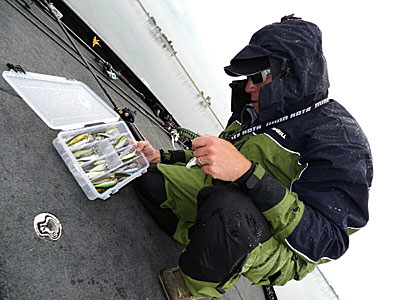
Regardless of the time of year, the influx of water can be positive. In the spring, when the main lake is still cold, run-off from storms will likely provide warmer water than the main body of water. In the summer, it’s likely to be just the opposite. The run-off will likely be cooler than the main lake, and the current and temperature increase will draw baitfish and bass to the source.
Smallmouths and their tendency to frequent larger, deep bodies of water are less prone to any changes in water temperature caused by local rain showers, but largemouths are different. Anglers are well aware that instead of largemouths going deeper in the summer, they often remain shallow, taking cover under a mat of weeds or lily pads that provide shade, cooler temperatures, and an array of aquatic and terrestrial forage.
A good rain shower affects largemouths in the skinny water more than any other bass. The downpour will cool the water, provide more oxygen and invigorate and spur the bass to go on a feeding frenzy. Put on the rain gear and ensure you’re on the water during a steady rain as long as there’s no lightning involved. Even better is that the jet skiers and other water zealots will be taking shelter.
Rain is often associated with wind, which can help orientate bass and make fishing even better. Wind will push baitfish, panfish, terrestrial insects, and creatures into vegetated shorelines. Bass will be waiting. The chop will also make bass feel more secure and facilitate a stealthy approach.
Ideally, you don’t get a deluge, but just a good rain that begins to bring water levels up, maybe an inch or two. Reservoirs that have been at extremely low levels will slowly begin to rise, and fishing opportunities will rise with it. Fishing will improve before, as bass sense the pending storm, when water levels begin to rise, and after when the influx of water influences the location of bass.
Lure selection depends mainly on how much rain fell and the resulting water clarity. If the incoming water is extremely dirty, opt for a spinnerbait. Spinnerbaits can be fished top to bottom, and they put out a lot of vibration that fish can quickly locate in dirty water and do an excellent job of imitating baitfish. Experiment with blade configuration and skirt colors until you hit the right combination. The right combination might be more about visibility and vibration than anything else.

If the water remains clear, you have a lot more options. Topwater lures can be gangbusters if the water remains clear and bass are concentrated. Jerkbaits, crankbaits, jigs, and tubes will work equally well. The key is identifying the most prevalent forage and picking the appropriate lure and presentation.
Bass anglers spend plenty of money on their favorite hobby. One investment they should make is in a good rain suit. “I can’t begin to tell you how many tournaments I’ve fished that I would not have been able to compete in if it weren’t for my Frabill F-4 Cyclone rain suit,” Balog said. “It would have been impossible to deal with the conditions and remain focused and positive without the F-4 rain suit. It kept me from getting cold and wet, and the weather was the last thing on my mind.”
Another piece of equipment that Balog recommends for fishing in the rain may not be so obvious. “Believe it or not, but sunglasses can be essential for fishing in the rain,” he said. “I don’t go on the water without amber, yellow and gray lenses for my glasses. It’s incredible how much better you can see on dark, overcast, rainy days with yellow lenses.
“It’s not 100% of the time, but there seem to be days when the yellow lenses will help you spot weed lines and holes in the weeds that you can not see with other lenses, especially in the fall. I don’t know if it’s the sun's angle or what, and it’s not all year round and not every day, but on certain days it makes a huge difference.”
Many people think a dark, dreary rainy day is perfect for curling up on the sofa with a good book. Savvy anglers know it’s an even better day to be slinging in the rain.


